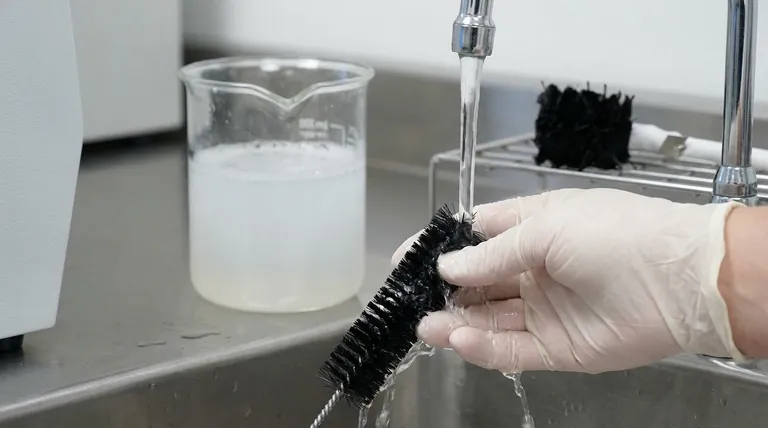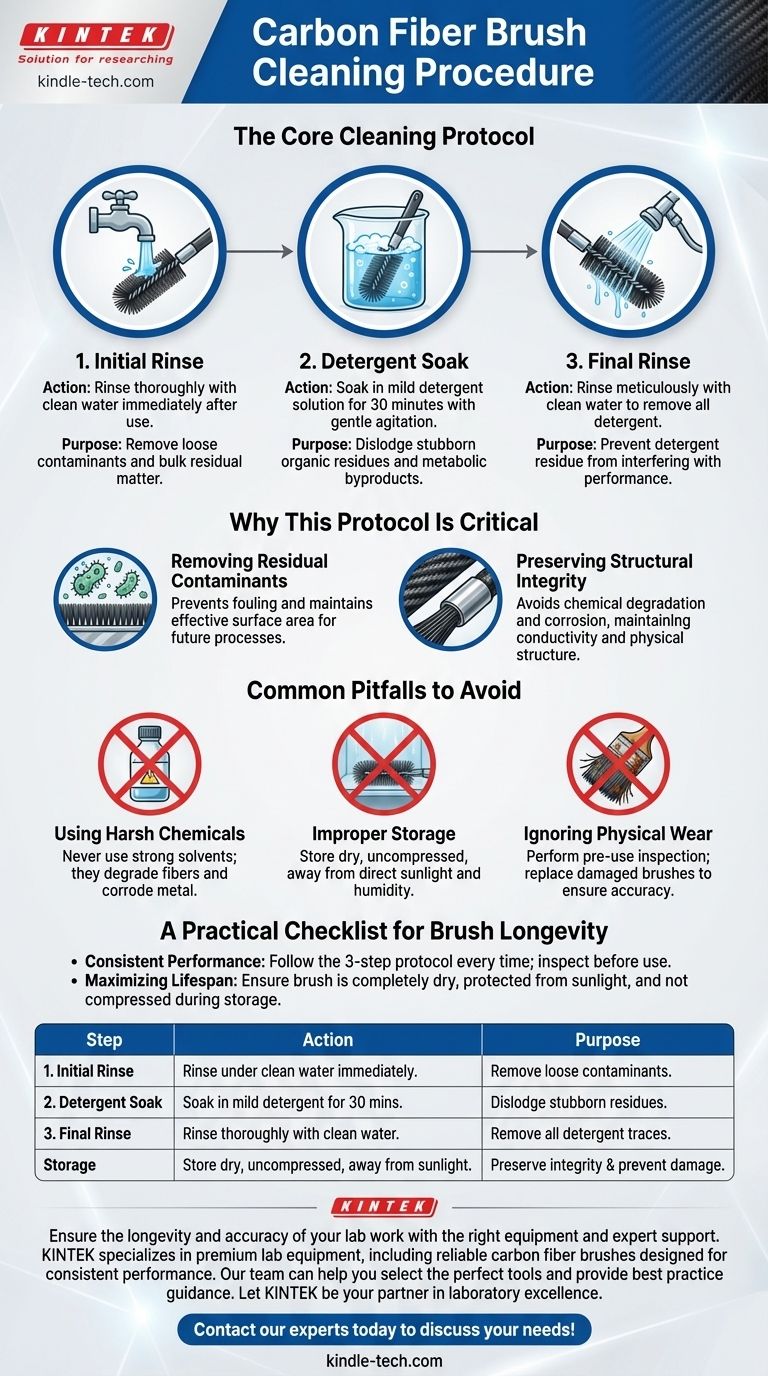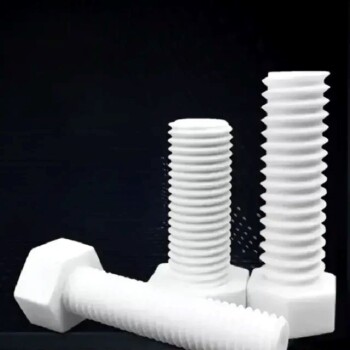To properly clean a carbon fiber brush, you must follow a three-step process. Begin by rinsing it with clean water to remove loose contaminants, then soak it in a mild detergent solution for approximately 30 minutes to dislodge stubborn residue, and finish with a thorough final rinse to eliminate any remaining detergent.
The goal of cleaning a carbon fiber brush is not merely to remove visible dirt, but to preserve its delicate physical structure and functional properties. An effective cleaning and storage protocol is essential for ensuring consistent performance and extending the brush's operational lifespan.

The Core Cleaning Protocol
Proper cleaning is a systematic process designed to be effective yet gentle. Each step serves a specific purpose in removing contaminants without damaging the sensitive carbon fibers or their metal fixings.
Step 1: The Initial Rinse
Immediately after use, rinse the brush thoroughly under clean water. This first pass is critical for removing the bulk of visible impurities and loose residual matter, such as microbial clusters from a wastewater environment.
Step 2: The Detergent Soak
Prepare a solution of mild detergent, such as a surfactant, mixed with water. Submerge the brush in this solution and let it soak for about 30 minutes. Gentle agitation or stirring during this period helps the detergent penetrate the dense fibers and dissolve more stubborn adhered contaminants and metabolic byproducts.
Step 3: The Final Rinse
After soaking, it is crucial to rinse the brush again, this time meticulously, with clean water. The objective is to remove all traces of the detergent. Any residue left behind could interfere with the brush's performance in its next application.
Why This Protocol Is Critical
Understanding the reasoning behind these steps helps reinforce their importance. The cleaning process is designed to address two primary concerns: biological/chemical contamination and physical integrity.
Removing Residual Contaminants
In applications like wastewater treatment, carbon fiber brushes become colonized by microbes. Their metabolic byproducts, if not removed, can foul the brush surface, reducing its effective area and hindering future microbial attachment or chemical processes. The detergent soak is specifically designed to break down these organic residues.
Preserving Structural Integrity
Carbon fibers are strong but can be brittle, and the metal wires fixing them can corrode. The protocol uses only mild detergents and water to avoid chemical degradation. This maintains the physical structure essential for the brush's performance, such as its conductivity and surface area.
Common Pitfalls to Avoid
Mistakes in cleaning or storage can irreversibly damage a carbon fiber brush. Avoiding these common errors is as important as following the correct procedure.
Using Harsh Chemicals
Never use acidic or alkaline solvents for cleaning. These aggressive chemicals can degrade the carbon fibers and accelerate the corrosion of any metal fixing wires, leading to shedding and a complete loss of function. Stick to neutral, mild detergents.
Improper Storage
After cleaning, the brush must be stored in a dry, well-ventilated area away from direct sunlight. Humidity can promote rust on metal parts, while UV exposure can age the fibers. Storing the brush under compression will deform the bristles, permanently altering its shape and effectiveness. For long-term storage, a sealed bag with a desiccant is recommended.
Ignoring Physical Wear
Before each use, perform a quick visual inspection. Look for significant shedding, broken fibers, or rust on the fixing wires. A brush with extensive damage will not perform as expected and should be replaced to avoid compromising your results.
A Practical Checklist for Brush Longevity
To ensure your carbon fiber brushes remain reliable, integrate these principles into your workflow.
- If your primary focus is consistent performance: Follow the three-step cleaning protocol without fail after every use and always perform a pre-use inspection for damage.
- If your primary focus is maximizing lifespan: Pay special attention to storage conditions, ensuring the brush is completely dry, protected from sunlight, and not compressed.
Proper maintenance is a small investment of time that protects the integrity of your equipment and the quality of your results.
Summary Table:
| Step | Action | Purpose |
|---|---|---|
| 1. Initial Rinse | Rinse under clean water immediately after use. | Remove loose contaminants and bulk residue. |
| 2. Detergent Soak | Soak in mild detergent solution for 30 minutes. | Dislodge stubborn organic residues and byproducts. |
| 3. Final Rinse | Rinse thoroughly with clean water. | Remove all detergent traces to prevent interference. |
| Storage | Store dry, uncompressed, away from sunlight. | Preserve structural integrity and prevent corrosion/UV damage. |
Ensure the longevity and accuracy of your lab work with the right equipment and expert support. Proper maintenance is key, and so is using high-quality, durable carbon fiber brushes. KINTEK specializes in premium lab equipment and consumables, including reliable brushes designed for consistent performance. Our team can help you select the perfect tools for your specific application and provide guidance on best practices.
Let KINTEK be your partner in laboratory excellence. Contact our experts today to discuss your needs and keep your processes running smoothly!
Visual Guide

Related Products
- Conductive Carbon Fiber Brush for Static Removal and Cleaning
- Laboratory Disc Rotary Mixer for Efficient Sample Mixing and Homogenization
- Small Jaw Crusher for Laboratory and Small Mines Efficient Flexible Affordable Laboratory Ore Crusher Coal Crusher
- Custom Machined and Molded PTFE Teflon Parts Manufacturer for Laboratory ITO FTO Conductive Glass Cleaning Flower Basket
- High Quality Alumina Ceramic Screw for Engineering Advanced Fine Ceramics with High Temperature Resistance and Insulation
People Also Ask
- What are 3 benefits of biomass energy? Turn Waste into Renewable Power
- How should a carbon fiber brush be stored after cleaning? Preserve Performance and Longevity
- Under what conditions should a carbon fiber brush be replaced? Identify Critical Failure to Ensure Performance
- What are the 3 types of biomass? A Guide to Woody, Agricultural, and Waste Sources
- What does the regular maintenance inspection of a carbon fiber brush entail? Ensure Peak Performance and Longevity















